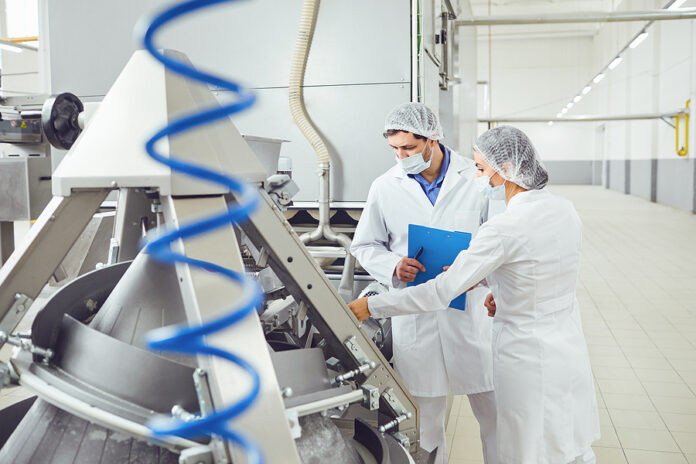
Do you feel like you’re swimming in COVID-19 guidance with no clear idea of how to operationalize it? This is a common problem in the food industry right now — between the CDC, and OSHA, and the FDA, there’s plenty of guidance, but it’s generally descriptive, not prescriptive, and many food manufacturers are having difficulty putting that guidance into practice in their plants. “Right now, guidance is platitudes, not programs,” said Paul Medeiros, Managing Director, Consulting and Technical Services, North America, at NSF International, a public health and safety company that helps organizations assess and manage their COVID-19 risk.
I spoke with Medeiros to learn why the food processing plants have been hotbeds for COVID-19 and what manufacturers need to do to keep their workers safe.
What’s going wrong at food plants?
To ensure food safety, the industry already follows rigorous cleaning protocols and has strict health standards for employees. But still, according to the Food & Environment Reporting Network, almost 60,000 workers in meatpacking plants, food processing plants, and farms and production facilities across the United States have had COVID-19, and at least 249 have died. Last month, Michigan mandated COVID-19 testing for all agricultural and food processing workers, the first state to do so. And last week, Tyson Foods, the food company with the most COVID-19 cases (more than 10,000) and deaths (35) among workers, announced plans to open medical clinics at several of its plants.
One big reason food plants have been hotbeds is because, as essential services, they stayed open. That, coupled with the nature of the work, in which people often stand close together, explains the initial outbreaks. But why, several months into the pandemic, are cases still high?
According to Medeiros, “many [companies] are not taking advantage of their advantages” — those advantages being the standards they already follow for their GFSI certification. “Some organizations, because they’re GFSI certified, they think they’re covered. But what we see is that they’re still subject to risk factors.”
Those risk factors include human error. Food plants are noisy, and Medeiros has heard stories about employees taking off their masks to yell at other employees simply so they can be heard.
They also include a failure to apply the safety protocols used in production areas to other parts of the facility, like the offices and cafeterias. “Food plants do pre-op inspections and other types of inspections daily,” Medeiros said, “but do the offices have the same controls?”
In part, these risk factors arise because training around COVID-19 safety is hard to come by. Often, the quality assurance manager (or whoever is in charge of safety programs) has to piecemeal their own training together from what’s currently available. Perhaps as a result, the new safety programs that are being launched in food plants aren’t often tested as well as they should be. Medeiros also noted the reality of pandemic fatigue. “People are tired.”
Assessing COVID-19 risk
Medeiros recommends approaching COVID-19 safety the same way you approach food safety: starting with a risk analysis.
This risk analysis has two parts: a proximity risk analysis and a common touchpoints risk analysis. “It’s all about the three Cs — close spaces, crowded places, and close contact settings,” Medeiros said.
The process is similar to developing a HACCP program. During the proximity risk analysis, you identify all of the places in your facility where people congregate or are in close contact. Once you’ve created the inventory, you can assess the level of risk. For example, are people just passing by one another or spending several minutes in the same area? The same applies to the common touchpoints analysis. First, identify common touchpoints in your facility (doors, handrails, microwaves, etc.), and then assess the level of risk. Once you know where your risks lie, you can determine how to control them.
Keeping workers safe
There’s no formula for how to keep workers safe. Like your HACCP program, the controls you use depend on the risks you identify. Medeiros offers three overarching principles to guide your decision-making.
-
- Employees should be wearing face coverings. Both OSHA and the CDC recommend that employers encourage employees to wear face coverings at work. If cloth face coverings aren’t feasible, employers can provide PPE.
- Think poka-yoke. Poka-yoke, which means “mistake-proofing” in Japanese, is a popular lean management concept that refers to putting controls in place to help people avoid making mistakes. Medeiros recommends doing this as often as possible. “You can try to rely on humans to remember to sanitize, etc., or you can put controls in place so that, in spite of people’s tendency to mess up, they won’t,” he said. Take physical distancing as an example. “Floor markings are great, but people ignore them; physical barriers are better. You can tell people not to crowd, but they will anyway; it’s better to stagger your start times, breaks, etc.”
- Put in multiple hurdles. “SARS-CoV-2 is like a runner in a race trying to get from one end to another (or one person to another),” Medeiros explained. “If you put in hurdles, the runner / virus is more likely to get tripped up.” The point is to combine approaches, putting multiple hurdles in the way of the virus spreading. The hurdle effect is already used in some segments of the food industry to ensure food safety. For COVID-19, hurdles include masks, physical distancing measures, handwashing reminders, sanitation procedures, employee screening, and so on. “Any one of these controls might be good, but people will make mistakes. So, the more programs you have in place, the better.”
A variety of technologies are available to help processors implement their chosen controls. Here are some that Medeiros finds particularly useful:
- Infrared temperature scanners to take employees’ temperatures upon their arrival at work
- Apps that allow employees to do their own health screening prior to coming in
- Apps that help with scheduling
- Any technology that permits employees to do things hands-free (e.g., time card punching)
All of these efforts will be easier with support from government and public health officials. “Regardless of what a business tries to do, their efforts are underpinned by public policy,” Medeiros said. “Wearing masks inside any kind of business is so much easier if it’s been mandated by executive order or state law. If you want to have testing of your employees, it’s easier if it’s mandated by law, especially if [the] local government has tests available and rapid turnaround.” He recommends becoming an advocate for your business by pestering local public health officials. “The more the state can do to help businesses, the better businesses will be able to help themselves.”
| Recommended reading: Contact Tracing, Social Distancing Monitoring, and Other Technologies for Keeping Workers Safe |
The importance of communication
Finally, always keep in mind the importance of communicating about your efforts. “You can’t overcommunicate,” Medeiros said. He recommends daily huddles or, if those aren’t possible, weekly meetings, to communicate updates to employees and also to get feedback from them about what’s working and what’s not.
Also keep in mind that communication is not just for your employees, but for their loved ones as well. “It’s not just about employees feeling comfortable, but also their families,” Medeiros said. Use your website, memos, emails, etc., to keep everyone informed. Independent verification programs, such as Checked by NSFTM, a program Medeiros helped found, can also help communicate to employees and their families that you’re doing the best you can.
If we’re being realistic, we know that COVID-19 is going to be with us for a while. The best way to protect your workers — and your business — is to stay vigilant and adapt your safety program as needed over time. As Medeiros noted: “It’s easy to think you’re doing everything right, but COVID-19 is a moving target, so what works today might not work three months from now, especially because of pandemic fatigue.”





![[Webinar] Unveiling the Top Trends Shaping the Food & Beverage Industry in 2025: Insights from an Industry Expert](https://foodindustryexecutive.com/wp-content/uploads/2024/09/Aptean-Unveiling-the-Top-Trends-Shaping-the-Food-Beverage-Industry-in-2025-Insights-from-an-Industry-Expert-1-218x150.png)

